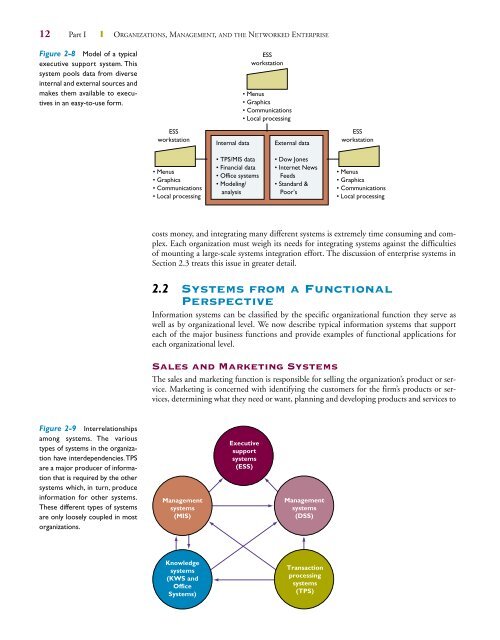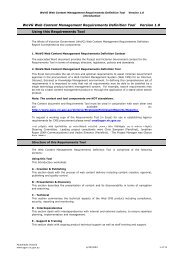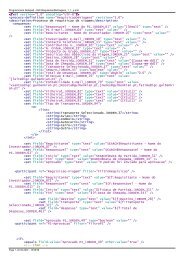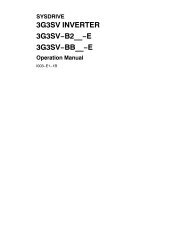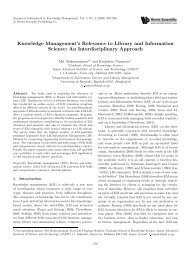2 Information Systems in the Enterprise - Main Web
2 Information Systems in the Enterprise - Main Web
2 Information Systems in the Enterprise - Main Web
Create successful ePaper yourself
Turn your PDF publications into a flip-book with our unique Google optimized e-Paper software.
12 Part I ❙ ORGANIZATIONS, MANAGEMENT, AND THE NETWORKED ENTERPRISE<br />
Figure 2-8 Model of a typical<br />
executive support system. This<br />
system pools data from diverse<br />
<strong>in</strong>ternal and external sources and<br />
makes <strong>the</strong>m available to executives<br />
<strong>in</strong> an easy-to-use form.<br />
Figure 2-9 Interrelationships<br />
among systems. The various<br />
types of systems <strong>in</strong> <strong>the</strong> organization<br />
have <strong>in</strong>terdependencies.TPS<br />
are a major producer of <strong>in</strong>formation<br />
that is required by <strong>the</strong> o<strong>the</strong>r<br />
systems which, <strong>in</strong> turn, produce<br />
<strong>in</strong>formation for o<strong>the</strong>r systems.<br />
These different types of systems<br />
are only loosely coupled <strong>in</strong> most<br />
organizations.<br />
ESS<br />
workstation<br />
• Menus<br />
• Graphics<br />
• Communications<br />
• Local process<strong>in</strong>g<br />
Management<br />
systems<br />
(MIS)<br />
Knowledge<br />
systems<br />
(KWS and<br />
Office<br />
<strong>Systems</strong>)<br />
Internal data<br />
• TPS/MIS data<br />
• F<strong>in</strong>ancial data<br />
• Office systems<br />
• Model<strong>in</strong>g/<br />
analysis<br />
• Menus<br />
• Graphics<br />
• Communications<br />
• Local process<strong>in</strong>g<br />
Executive<br />
support<br />
systems<br />
(ESS)<br />
ESS<br />
workstation<br />
External data<br />
• Dow Jones<br />
• Internet News<br />
Feeds<br />
• Standard &<br />
Poor’s<br />
Management<br />
systems<br />
(DSS)<br />
Transaction<br />
process<strong>in</strong>g<br />
systems<br />
(TPS)<br />
ESS<br />
workstation<br />
• Menus<br />
• Graphics<br />
• Communications<br />
• Local process<strong>in</strong>g<br />
costs money, and <strong>in</strong>tegrat<strong>in</strong>g many different systems is extremely time consum<strong>in</strong>g and complex.<br />
Each organization must weigh its needs for <strong>in</strong>tegrat<strong>in</strong>g systems aga<strong>in</strong>st <strong>the</strong> difficulties<br />
of mount<strong>in</strong>g a large-scale systems <strong>in</strong>tegration effort. The discussion of enterprise systems <strong>in</strong><br />
Section 2.3 treats this issue <strong>in</strong> greater detail.<br />
2.2 <strong>Systems</strong> from a Functional<br />
Perspective<br />
<strong>Information</strong> systems can be classified by <strong>the</strong> specific organizational function <strong>the</strong>y serve as<br />
well as by organizational level. We now describe typical <strong>in</strong>formation systems that support<br />
each of <strong>the</strong> major bus<strong>in</strong>ess functions and provide examples of functional applications for<br />
each organizational level.<br />
Sales and Market<strong>in</strong>g <strong>Systems</strong><br />
The sales and market<strong>in</strong>g function is responsible for sell<strong>in</strong>g <strong>the</strong> organization’s product or service.<br />
Market<strong>in</strong>g is concerned with identify<strong>in</strong>g <strong>the</strong> customers for <strong>the</strong> firm’s products or services,<br />
determ<strong>in</strong><strong>in</strong>g what <strong>the</strong>y need or want, plann<strong>in</strong>g and develop<strong>in</strong>g products and services to


